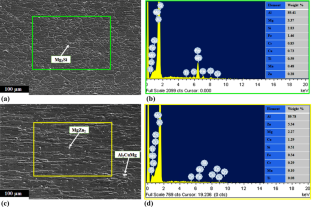Journal of Materials Engineering and Performance ( IF 2.3 ) Pub Date : 2024-04-15 , DOI: 10.1007/s11665-024-09444-0 Md Saquib Bin Reyaz , Amar Nath Sinha

|
The primary focus of this investigation is to examine the impact of friction stir processing (FSP) parameters on the tungsten inert gas (TIG) welded dissimilar AA6061-T6 and AA7075-T6 joints. Tool spindle speed, feed rate, tilt angle, and tool pin configuration were selected as input processing variables. A regression model was built using a central composite rotatable design matrix (CCRD) and response surface methodology (RSM) to forecast the mechanical features such as ultimate tensile strength (UTS), percentage elongation (PE), microhardness (MH), and residual stress (RS). Analysis of variance (ANOVA) was used to estimate the adequacy of the built-up models and identify significant terms. The results revealed that the tool pin configuration was found to be the most influential processing parameter relative to other parameters. The TIG + FSP joint fabricated with cylindrical threaded with triflat faces (THF) pin configuration has the highest mechanical properties and low residual stresses. The TIG + FSP joint showed an optimal UTS of 279.93 MPa, a PE of 20.92%, an MH of 115.42 HV, and a RS of 19.95 MPa when using a tool spindle speed of 1106.39 rpm, a feed rate of 45.79 mm/min, a tilt angle of 2.00 degrees, and a THF pin configuration. TIG joints exhibited brittle failure because of the rough cleavage facet and macro voids, while TIG + FSP joints exhibited brittle failure due to fine dimples and no voids. Electron backscatter diffraction showed that TIG + FSP welding produced ultrafine grains and significant grain boundary strengthening compared to TIG joints. Pole figures showed some recrystallization \({\text{A}}_{1}^{*}\)/\({\text{A}}_{2}^{*}\) and A/\(\stackrel{\mathrm{-}}{\text{A}}\) textures in the TIG joint at the FZ center, whereas the TIG + FSP joint exhibited significant shear deformation B/\(\overline{\text{B}}\) and C textures at the SZ center. Moreover, the intensity of texture in the TIG joint was only 3.02, while it was 10.34 in the TIG + FSP joint, indicating that significant texture strengthening occurred after FSP.
中文翻译:

模拟工具销配置和搅拌摩擦加工参数对钨极惰性气体保护异种铝合金接头的影响
本研究的主要重点是检查搅拌摩擦加工 (FSP) 参数对钨极惰性气体 (TIG) 焊接异种 AA6061-T6 和 AA7075-T6 接头的影响。选择刀具主轴转速、进给速率、倾斜角度和刀具销配置作为输入加工变量。使用中心复合旋转设计矩阵 (CCRD) 和响应面法 (RSM) 建立回归模型来预测极限拉伸强度 (UTS)、伸长率 (PE)、显微硬度 (MH) 和残余应力等机械特性(RS)。方差分析 (ANOVA) 用于估计构建模型的充分性并识别重要项。结果表明,相对于其他参数,工具销配置是最具影响力的加工参数。采用带三平面 (THF) 销配置的圆柱螺纹制造的 TIG + FSP 接头具有最高的机械性能和较低的残余应力。当刀具主轴转速为 1106.39 rpm、进给率为 45.79 mm/min 时,TIG + FSP 接头的最佳 UTS 为 279.93 MPa,PE 为 20.92%,MH 为 115.42 HV,RS 为 19.95 MPa。 2.00 度的倾斜角和 THF 引脚配置。 TIG 接头由于粗糙的解理面和大空隙而表现出脆性破坏,而 TIG + FSP 接头由于细韧窝且无空隙而表现出脆性破坏。电子背散射衍射表明,与 TIG 接头相比,TIG + FSP 焊接产生超细晶粒和显着的晶界强化。极图显示了一些重结晶\({\text{A}}_{1}^{*}\) / \({\text{A}}_{2}^{*}\)和 A/ \(\ FZ 中心 TIG 接头中的stackrel{\mathrm{-}}{\text{A}}\)纹理,而 TIG + FSP 接头表现出显着的剪切变形 B/ \(\overline{\text{B}} \)和 SZ 中心的 C 纹理。此外,TIG接头中的织构强度仅为3.02,而TIG+FSP接头中的织构强度为10.34,表明FSP后发生了显着的织构强化。



























 京公网安备 11010802027423号
京公网安备 11010802027423号